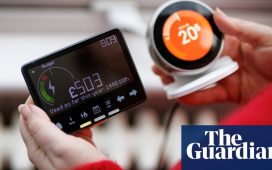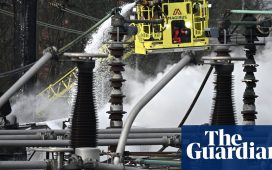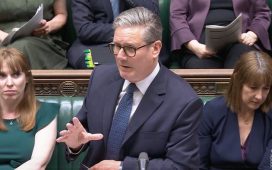Unlock the Editor’s Digest for free
Roula Khalaf, Editor of the FT, selects her favourite stories in this weekly newsletter.
The cost of UK carbon emissions permits has fallen to an all-time low, raising fears it will weaken the incentive to build cleaner renewable energy sources.
Futures contracts tracking the UK carbon price to December dropped to £31.48 per tonne of carbon dioxide on Monday, with analysts blaming the decline on the mild winter weather, slowing demand from industrial users and an excess of permits available to cover pollution in Britain.
The price has recovered marginally, closing on Thursday up 6.4 per cent at £36.71, but is trading at its lowest since the UK started its replacement for the EU trading scheme in May 2021 following Brexit.
That marks a 43 per cent decline compared with a year ago and a hefty discount to the €62-a-tonne price quoted on its EU rival, as well as similar schemes in the US.
UK prices have been under pressure on concern over an economic slowdown and intensified after the government introduced generous levels of allowances last July.
Under the scheme, heavy polluters such as gas-fired power plants and refineries have to buy allowances to pay for any emissions above a threshold. Over time polluters are pushed towards cheaper and lower carbon forms of energy and production.
The low prices are “really concerning” as the emissions trading scheme “is probably the UK’s primary decarbonisation mechanism”, said Adam Berman, deputy policy director at energy industry trade group Energy UK.
“We need a strong, stable and predictable carbon price signal to ensure that investment heads in the right direction,” he added. “A low carbon price sends absolutely the wrong signal about the UK’s commitment to net zero.”
Marcus Ferdinand, chief analytics officer at carbon consultancy Veyt, said the slide also reflected “constantly eroding trust in the market as climate policies are weakening under the Sunak government”.
In September, the government delayed the UK’s planned ban on the sale of new petrol and diesel cars from 2030 to 2035, and also weakened measures to get households to move away from gas-fired boilers for home heating.
The government has said it remained committed to its legally binding target of cutting carbon dioxide emissions to net zero by 2050, as well as to interim targets.
“If we want to electrify transport and heat, and power them with renewables, then it’s going to be very difficult to do that without the higher carbon price to fund and incentivise it,” said James Huckstepp, analyst at BNP Paribas.
However, Veyt and others expect the UK’s carbon price to rise in the latter half of the decade as the emissions scheme is tightened up. The number of allowances auctioned through the UK ETS would reduce this year and would be 45 per cent lower by 2027, the Department for Energy Security and Net Zero said.
“We have already halved emissions since 1990, faster than any other major economy, and these measures will be a key pillar in going further to meet our climate commitments,” it added.
“We think in the mid to long run, the UK system will get very tight, and prices are expected to increase significantly over the next years,” said Ferdinand.
The market is “ignoring the promise of significant supply cuts and challenges around further emission reductions over the second half of the decade,” said Huckstepp.










